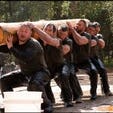The arms are one of the first things you see on a person. Whether it’s that thick horseshoe shape on the back of their arm, or the big, bulbous biceps in the front, it’s easy to respect a big, strong set of arms, because you know that person has put the work in to get them.
So, it makes sense to want to craft your monster set of man melons (biceps) and omega mass (triceps). Here are a few things to consider when training your arms to make sure you get the most benefit possible.
Bigger Arms Through Training Frequency
Most people who train to build muscle operate under the assumption that they should only train arms once a week because that is what others have told them at the gym and the magazines on the market.
I was under that impression for a while too but think about something for a minute…
You may not realize it, but you are probably already training your arms more than once a week.
For instance, if your training split involves a chest day, a shoulder day, a back day and an arm day, then you are already working your triceps hard on three days (chest, shoulder and arm Days), and you are already hitting your biceps hard twice (back day and arm day).
This goes to show that, the arms can handle the extra work, especially if you have been training for a year or so. With that in mind, if you want to build bigger arms, you should consider adding in even more arm-specific work.
Keep your split the way it is, but on those bigger muscle group days (chest, shoulders, back) add in some more quality arm-specific training for the biceps or triceps at the end of your workout.
Bigger Arms & Training Tempo
Lifting tempo is the combination of the speed it takes you to perform the concentric portion (muscle shortening) of a lift and the eccentric portion (muscle lengthening) of a lift. It is usually written like this: 1:1, where the first 1 is the concentric portion and the second 1 is the eccentric portion.
An example would be Dumbbell Curls, where it takes 1 second for you to curl the dumbbell up and then 1 second to lower it back down.
The 1:1 tempo is the way 99% of the people in the gym looking to build their arms do things 100% of the time. Unfortunately, they are killing their results, because the eccentric portion is where most of the damage to the muscle takes place. That damage is what causes the muscle to grow.
With this in mind, it makes no sense to have such a short, eccentric contractions. At least, not all of the time. So, the next time you train arms, target one of the exercises to lengthen the eccentric contraction.
Go from 1 second to 2 or 3 seconds. This will cause more microtrauma to the muscle and hopefully, lead to more growth in your arms.
In another workout shortly down the line, try increasing the eccentric portion of the tempo in two exercises. Then, gradually modify the majority of your training so that the eccentric part of the lift slows down even further.
Try that out for a while and make a note of the changes you experience when you look in the mirror when you put on your shirt, and when you walk down hallways. The lateral head of your triceps will start knocking pictures off the wall!
Focus on Training Intensity for Bigger Arms
Most people work the same rep ranges on every single arm training exercise they do. This is usually in the 8 to 12 rep range. That’s OK for a while, but eventually, you need to throw in rep ranges that are lower and higher. Your body gets used to the same thing all the time and eventually stops responding. Here are some things to try.
Train for Arm Strength: Instead of always looking at the 8 to 12 rep volume, try training for strength by increasing the weights and decreasing the reps to the 3 to 5 rep range. This might feel quite foreign at first but stick with it. There’s nothing wrong with working toward STRONG arms on top of having BIG arms.
This video shows some heavy dumbbell curls, testing max biceps strength:
Train for Bigger Arms with Eccentric Only
As I said above, the eccentric portion of the exercise is where most of the damage occurs, so the good idea is to ONLY perform that portion of the exercise.
Also, you can exert more force in the eccentric range of motion than the concentric range of motion, so you’ll be able to increase the weight here significantly. Work in the 3 to 5 rep range here. If you can get 6 reps, you should use a heavier weight.
This video shows some eccentric only training:
Get Bigger Arms with Ultra Endurance Training
This section is all about getting away from the black hole of 8 to 12 reps all the time, so the next initiative to take is to completely blow that range out of the water by doing sets of just insane numbers of reps per set.
Here is an example I have been trying recently. It is the Poundstone Curl Challenge, originated by Professional Strongman Competitor, Derek Poundstone. The idea is to take an empty 45-lb barbell and try to curl it 100 times in one long, gigantic, monster-volume set.
Try this one time, and you will hate Derek Poundstone as much for introducing this maniacal idea to the world.
WARNING: This kind of volume makes your arms just plain hurt. It will also make them grow like crazy. So be ready for both.
Here’s my video the first top I got 100 reps:
Making these changes to your arm training will have a profound effect on your results. Not only will your arms grow, they will get stronger as well. More strength is always something that everyone can use.
Naturally, be sure to use proper form, the right range of motion, and always incorporate stretching to maintain your movement quality while doing this kind of intense training for bigger arms.
Jedd Johnson runs DieselCrew.com, a site dedicated to strength training and muscle-building. Sign up for his free newsletter, The Diesel Files. For more strength training and muscle-building ideas, be sure to subscribe to my channel on Youtube.

)





